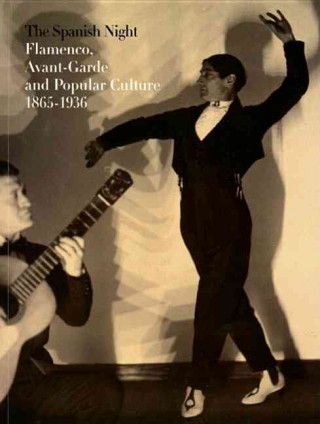
Kod: 13121157
The Spanish night : flamenco, avant-garde and popular culture, 1865-1936
Autor Josephine Watson
Both flamenco, conceived as modern popular culture, and the artistic avant-garde arise during the late nineteenth century. The aim of this exhibition is to review for the first time the position of flamenco within the frame of vis ... więcej
- Język:
 Angielski
Angielski - Oprawa: Miękka
- Liczba stron: 400
Wydawca: Museo Nacional Centro de Arte Reina Sofía, 2008
- Więcej informacji o książce

57.51 zł
Zwykle: 58.03 zł
Oszczędzasz 0.52 zł
Dostępność:
50 % szansa Otrzymaliśmy informację, że książka może być ponownie dostępna. Na podstawie państwa zamówienia, postaramy się książkę sprowadzić w terminie do 6 tygodni. Gwarancja pełnego zwrotu pieniędzy, jeśli książka nie zostanie zabezpieczona.
Otrzymaliśmy informację, że książka może być ponownie dostępna. Na podstawie państwa zamówienia, postaramy się książkę sprowadzić w terminie do 6 tygodni. Gwarancja pełnego zwrotu pieniędzy, jeśli książka nie zostanie zabezpieczona.Przeszukamy cały świat
Zobacz książki o podobnej tematyce
-

Dune
34.84 zł -33 % -

Haunting Adeline
125.81 zł -1 % -

Berserk Deluxe Volume 2
212.65 zł -1 % -

White Nights
15.30 zł -23 % -

Powerless
48.75 zł -11 % -

Atomic Habits
59.22 zł -26 % -

Dune Messiah
46.33 zł -3 % -

Berserk Deluxe Volume 3
218.19 zł -3 % -

One Day
32.63 zł -36 % -

Berserk Deluxe Volume 1
211.84 zł -2 % -

Iron Flame
61.14 zł -28 % -

Surrounded by Idiots
36.76 zł -28 % -

Harry Potter and the Prisoner of Azkaban (Minalima Edition)
170.44 zł -2 % -

Gravity Falls Journal 3
89.45 zł -

Heaven Official's Blessing: Tian Guan Ci Fu (Novel) Vol. 1
88.94 zł -1 % -

The Creative Act
100.22 zł -15 % -

Dune
47.34 zł -23 % -

Hunting Adeline
126.52 zł -4 % -

A Little Life
47.04 zł -14 % -

Children of Dune
46.73 zł -2 % -

Heaven Official's Blessing: Tian Guan Ci Fu (Novel) Vol. 2
77.76 zł -14 %
Bon podarunkowy: Radość gwarantowana
- Podaruj bon o dowolnej wartości, a my się zajmiemy resztą.
- Bon podarunkowy dotyczy całej naszej oferty.
- Możesz wydrukować elektroniczny bon z e-maila a następnie przekazać go obdarowanemu.
- Ważność bonu wynosi 12 miesięcy od daty wystawienia.
Powiadomienie o dostępności
Wpisz swój adres e-mail, aby otrzymać od nas powiadomienie,
gdy książka będzie dostępna. Proste, prawda?
Więcej informacji o The Spanish night : flamenco, avant-garde and popular culture, 1865-1936
Za ten zakup dostaniesz 34 punkty
 Opis
Opis
Both flamenco, conceived as modern popular culture, and the artistic avant-garde arise during the late nineteenth century. The aim of this exhibition is to review for the first time the position of flamenco within the frame of visual culture, especially its relationship of mutual influence with avant-garde art and modernity. The chronological order of opening and closing the exhibition (1865-1936) has been determined according to two significant dates. The first, 1865, is the year Manet travels to Spain to see the paintings of his Spanish masters up close, and the time in which the singer Silverio Franconetti returns to Seville, where he lays the basis of what will soon be flamenco singing. Also during this year the railway line linking Andalusia with Madrid and Paris is finished, which facilitates the diffusion of Andalusian culture, and extends movements that announce the First Republic. At that time dancers are self-taught and their workplaces are parties or live music cafes. In 1936 the Spanish Civil War breaks out and the dancer Antonia Mercé "La Argentina" dies. At this time dark images begin to appear, moving towards the grotesque and the macabre, among them the skeletons of Ragel or Masson. In parallel, the dancers evolved; some have classical training and begin to perform in large theatres and cinemas. This exhibition covers all artistic manifestations and items related to flamenco. For it, about four hundred and fifty pieces have been collected having been produced by one hundred and fifty authors; works including paintings, sculptures, photographs, decorative and figurine drawings -as well as original costumes- for dance and theatre, films, publications and documents.
 Szczegóły książki
Szczegóły książki
57.51 zł
- Pełny tytuł: The Spanish night : flamenco, avant-garde and popular culture, 1865-1936
- Autor: Josephine Watson
- Język:
 Angielski
Angielski - Oprawa: Miękka
- Liczba stron: 400
- EAN: 9788480263726
- ISBN: 8480263725
- ID: 13121157
- Wydawca: Museo Nacional Centro de Arte Reina Sofía
- Waga: 1379 g
- Wymiary: 240 × 180 × 35 mm
- Data wydania: October 2008
zadowolonych klientów
Od roku 2008 obsłużyliśmy wielu miłośników książek, ale dla nas każdy był tym wyjątkowym.
Copyright! ©2008-24 libristo.pl Wszelkie prawa zastrzeżonePrywatnieCookies


 21 milionów książek
21 milionów książek Dostawa 10.99 zł
Dostawa 10.99 zł (32) 444 93 66 (8-15.30h)
(32) 444 93 66 (8-15.30h)